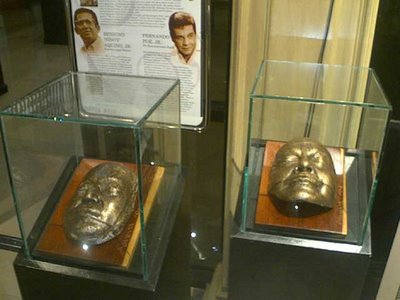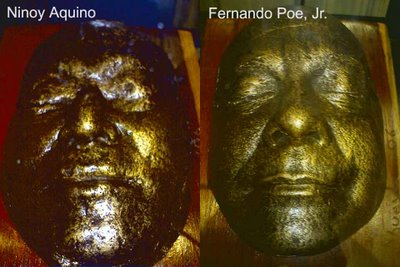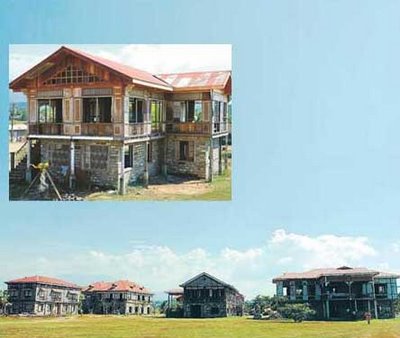I was at the Center for Kapampangan Studies yesterday afternoon for one of my regular visits which have been rare nowadays due to all the work and traveling. I got a copy of the Atin Ku Pung Singsing (Millennium Version) MTV which they produced and uploaded it in YouTube. On our way down, I realized that the death masks of Ninoy Aquino and Fernando Poe, Jr. were on display at the Center. So I checked them out.
 The masks were done by National Artist Napoloen Abueva. Abueva said he was very careful when he cast the mask of Ninoy since his face had a lot of blood. In fact, you could still see the swelling, some of the bigger wounds and the spot where a bullet exited on his chin. FPJ's mask was more defined since Abueva did not have to deal with the same situation as Ninoy.You may be asking what the hell is the death mask of Fernando Poe, Jr. doing in the Center for Kapampangan Studies. Now this is something I'm sure you did not know... GMA and FPJ are townmates from Lubao. Haha! No kidding!It turns out, FPJ's mom Bessie Kelley was born in Candaba, Pampanga. Her full name is Elizabeth Gatbonton Kelley. She is the daughter of Arthur Kelley of Iowa, USA and Marta Gatbonton of Candaba. I was told that Arthur Kelley, for the longest time, was a resident of Lubao because of his interests in the Pampanga Sugar Mill (PASUMIL) in neighboring Floridablanca. In fact, there are Kelleys who still reside in Lubao up to today and rumor has it FPJ visited his cousins occasionally.What a coincidence! GMA and FPJ are both Kapampangan and Pangasinense! I wonder why FPJ's Pampanga roots never came out during the elections. All of a sudden, all of us at the Center became silent, looked at each other and realized it was the 2nd death anniversary of FPJ. And we were looking at his death mask! Now that's another coincidence.
The masks were done by National Artist Napoloen Abueva. Abueva said he was very careful when he cast the mask of Ninoy since his face had a lot of blood. In fact, you could still see the swelling, some of the bigger wounds and the spot where a bullet exited on his chin. FPJ's mask was more defined since Abueva did not have to deal with the same situation as Ninoy.You may be asking what the hell is the death mask of Fernando Poe, Jr. doing in the Center for Kapampangan Studies. Now this is something I'm sure you did not know... GMA and FPJ are townmates from Lubao. Haha! No kidding!It turns out, FPJ's mom Bessie Kelley was born in Candaba, Pampanga. Her full name is Elizabeth Gatbonton Kelley. She is the daughter of Arthur Kelley of Iowa, USA and Marta Gatbonton of Candaba. I was told that Arthur Kelley, for the longest time, was a resident of Lubao because of his interests in the Pampanga Sugar Mill (PASUMIL) in neighboring Floridablanca. In fact, there are Kelleys who still reside in Lubao up to today and rumor has it FPJ visited his cousins occasionally.What a coincidence! GMA and FPJ are both Kapampangan and Pangasinense! I wonder why FPJ's Pampanga roots never came out during the elections. All of a sudden, all of us at the Center became silent, looked at each other and realized it was the 2nd death anniversary of FPJ. And we were looking at his death mask! Now that's another coincidence.
All our ASEAN neighbors take pride in their old markets. In fact, they go out of their way to preserve and even restore them. As a result, they are popular destinations among locals and tourists alike.
Kuala Lumpur still has its Central Market, an Art Deco building which is very popular with tourists. It is in fact a declared heritage site of Malaysia and even has its own website, complete with the story of its near demise. The website notes that "it became the first case for large scale adaptive re-use of a building by the private sector after plans to demolish it were scrapped following public protest." It adds that the market "is unlike any other soul-less modem shopping complex in the city."
Singapore has the Telok Ayer Market. Just like its counterpart in KL, this is a declared national monument of Singapore. When tunneling work for the MRT began in 1986, instead of demolishing the market, realizing the historical and architectural value of the market, Singapore dismantled it and put this heritage treasure in storage. It was rebuilt as soon as the MRT tunnel was completed.
 Now for Manila. We got this message from Archt. Richard Tuason-Sanchez Bautista of the NCCA: "I happen to pass by three Markets in Manila: Central Market, Quinta, and Paco. All have sign boards that mention about a new market that will be erected in the same site. Quinta is already partially demolished, and demolition is on going. Paco Market, which is among the loveliest market will go the same way."
Now for Manila. We got this message from Archt. Richard Tuason-Sanchez Bautista of the NCCA: "I happen to pass by three Markets in Manila: Central Market, Quinta, and Paco. All have sign boards that mention about a new market that will be erected in the same site. Quinta is already partially demolished, and demolition is on going. Paco Market, which is among the loveliest market will go the same way."
Above is a photo of the Paco Market which was built circa 1910, courtesy of Archt. Bautista. In the inset is one of the Art Deco buildings that surround the Paco Market. This area, with several Art Deco buildings still standing, would have been a great place for rehabilitation and urban renewal efforts if Manila's planners and engineers were only forward looking.Mayor Lito Atienza, for the love of Philippine culture, please stop destroying the architectural heritage of Manila!
* * *
Update: I just got a text message from Archt. Bautista who immediately called an engineer from the Manila City Hall. According to him, they will repair parts of the markets and re-layout the place, but not demolish. Let's hope and pray that this is true and that they will not modify the exteriors of these markets. But Richard added that based on what they have done before, such as the Trabajo Market, they changed the entire structure!
I also got to speak with Archt. Lorelei de Viana of the NHI who said that Paco Market must have been designed by Archt. William Parsons. Same goes for the Arranque Market which the City Government of Manila has already altered beyond recognition. So we better make sure Paco Market is preserved!
Check out the front page of the Philippine Daily Inquirer. The Pio Chapel and Bagac project issue is discussed. This is an example of how a community and an entire province can unite to save its architectural heritage. Indeed, this is good news for Pampanga which celebrates its 435th anniversary today. SPECIAL REPORTNew ‘old town’ of heritage houses fuels furorBy Tonette OrejasPORAC, PAMPANGA -- Sitting on a bamboo bench by the roadside, 86-year-old Felicidad Lising let out an expression of outrage her neighbors in the village of Pio here do not usually hear from the mild-mannered grandmother.“Ay Dios ko! E ustu ita (Oh my God! That’s a wrong thing to do),” Lising said, casting her droopy eyes on the village’s 145-year-old Catholic chapel.It has unsettled her, she said, that the chapel has been bought and destined for transfer to Bagac town, Bataan province. Read more...
SPECIAL REPORTNew ‘old town’ of heritage houses fuels furorBy Tonette OrejasPORAC, PAMPANGA -- Sitting on a bamboo bench by the roadside, 86-year-old Felicidad Lising let out an expression of outrage her neighbors in the village of Pio here do not usually hear from the mild-mannered grandmother.“Ay Dios ko! E ustu ita (Oh my God! That’s a wrong thing to do),” Lising said, casting her droopy eyes on the village’s 145-year-old Catholic chapel.It has unsettled her, she said, that the chapel has been bought and destined for transfer to Bagac town, Bataan province. Read more...
Update
The second part of the special report has been published. Check out ‘Old town’ for posterity, says developer in the Philippine Daily Inquirer. I would agree with Acuzar on the point that he is not breaking the law since the structures are not NHI-declared. That simply means that the NHI is slow and is not doing its job since Acuzar himself admitted that two of the structures he is currently transferring are historically important! Which is why he wants to keep quiet about it first so that it doesn't raise any howls until the transfer is completed. I also agree with his chief architect Joel Rico that most of the heritage laws in the Philippines only ensure protection, not funding. Which is why Congress better enact the heritage bills fast!
But sad to say, Rico is not a trained restoration architect. Even if Acuzar says houses are transferred "as is," visitors to his project have commented that the houses were not assembled properly.
The main issue here is not simply the transfer but the fact that Acuzar is actively shopping for old houses, trying to woo the owners into selling their properties to him! How ironic that he mentions Scandanavia where "culture is preserved in structures." If he was indeed to follow the example he cited, structures should remain where they are, preserved together with the environment they were built in!
As I always say, the best way to preserve a structure is to educate the local community about its importance to the history and heritage of the place, as well as its economic potential if preserved properly.
I would have more respect for Acuzar if instead of uprooting all these structures from the communities where they form an inherent part of the historical and cultural fabric; since he has all the money to spend anyway, he should instead build replicas! In that manner, communities get to keep their heritage.

 The masks were done by National Artist Napoloen Abueva. Abueva said he was very careful when he cast the mask of Ninoy since his face had a lot of blood. In fact, you could still see the swelling, some of the bigger wounds and the spot where a bullet exited on his chin. FPJ's mask was more defined since Abueva did not have to deal with the same situation as Ninoy.
The masks were done by National Artist Napoloen Abueva. Abueva said he was very careful when he cast the mask of Ninoy since his face had a lot of blood. In fact, you could still see the swelling, some of the bigger wounds and the spot where a bullet exited on his chin. FPJ's mask was more defined since Abueva did not have to deal with the same situation as Ninoy.

